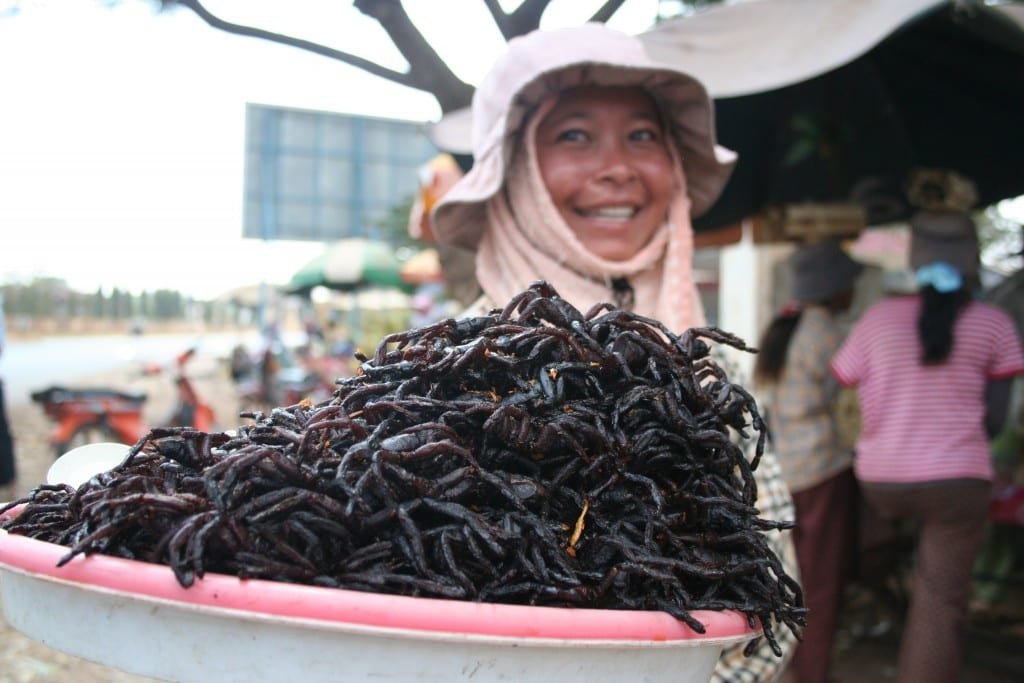By Andrew Kolasinski
A bizarre sight greeted me when I checked into my Phnom Penh guest house. In the lobby trashcan I saw a takeaway food tray with noodle residue topped by two huge black spiders – tarantulas!
The next night sitting with friends at a sidewalk café a street vendor offered a platter of fried spiders. Succumbing to curiosity I regarded my snack with doubts. My friends advised me that the thorax of the tarantula was filled with soft goo that wasn’t palatable but the legs were a fine snack.
The taste was a bit nutty, the skin was crunchy. The pencil thick legs were salty with a hint of garlic. It went well with cold Angkor beer. The meat of the abdomen is white like chicken. The organ cavity should be avoided.
Zebra Tarantulas (Haplopelma albostriatum) are a common food in Cambodia, though the origins of the meal are unclear. Tarantulas and other large spiders are also eaten in Thailand, Vietnam and The Philippines among remote tribes, but in Cambodia spiders became a mainstream food source.
The area around Toni Sap and in particular, Skuon, a town halfway between Phnom Penh and Siem Reap, is the center of spider eating. Ah-ping as they are called in the Khmer language grow to the size of your palm. In the Skuon countryside ah-ping are hunted in the remaining pockets of rainforest. Some claim the spiders are raised agriculturally, but I found no proof they could be domesticated.
The popularity of eating tarantulas has raised questions about sustainability, though vendors are confident they are abundant. The greatest risk to their numbers may be deforestation and expanded farmlands, and farmers often just kill them.
Tarantulas dig holes in the ground from which they ambush-attack insects, birds and small mammals. Their big fangs deliver a venomous bite, but are not deadly to humans or other large animals; however their poison would cause intense pain and sickness. The name Zebra Tarantula stems from their white striped legs and the zigzag pattern on their bodies. Species of tarantulas in the Americas and Europe also carry toxic hairs on their bodies, which are lacking on the Asian Zebra Tarantula making them suitable as food. They weave only a few strands of web with which they detect the movements of prey.
In Cambodia eating tarantulas is a recorded practice for over a hundred years. During the horror of the Khmer Rouge regime when most Cambodians were living on starvation diets, tarantulas and other foraged creatures became essential foods. They have quite a bit of edible meat and are rich in protein. Their meat is also a good source of folic acid, zinc and other nourishing elements. Some think they have healing properties as well. They are marinated in rice wine, creating a potion to help with respiratory problems and arthritis. The toxins from their fang are credited with medical benefits.
Tarantulas are just one of the creepy crawlers that Cambodians have accepted as food. They also eat fried crickets, grasshoppers and giant water beetles. Certainly fist-size spiders have the most shock value considering the arachnophobia so common among westerners whose fear and revulsion are not shared by Cambodians. This same strong reaction has made tarantula eating a rite of passage and badge of honor among foreign tourists.
The rich flavors of tarantula come largely from the way they are prepared. They are killed by drowning, at the same time washing them. Then they are shaken in a mixture of salt, monosodium glutamate and garlic before they are fried to a crisp in an oil filled pan.
Born in The Hague, Andrew Kolasinski arrived in Canada as a small child riding in the luggage rack of a DC-7. Since then he has felt at home anywhere. As the publisher and editor of Island Angler, Andrew spends half the year fishing for salmon and trout, and in the off-season he travels the world looking for a story. This article was written on behalf of Tucan Travel, providers of adventure tours to Cambodia and all over Southeast Asia.
If you would like to submit a guest post on food, wine or travel to Where and What in the World, I would be happy to feature your travel experience , drink, special wine tasting, or family or simply delicious recipe. If you go to submission tab, you will see how to submit, as well as have the opportunity of telling me if you would like to would like to be a regular contributor. When uploading a file for submission, you are also able to upload jpgs. Please feel free to put a last paragraph about you and a link to your profile. No html please. You can also include a head shot.















